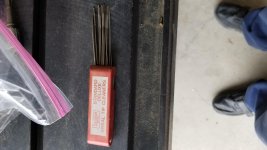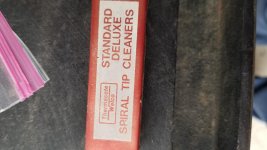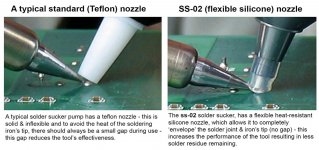A friend was over the other day to recap his crossovers. I have a solder sucker but it really doesn't clean out all the old solder and we had a hard time removing all the solder. Then I remembered this little tool I use to clean out my gas welder tips.
I could pass these tiny round files through what little holes were left after we cleared out the solder.
Works really well and easy and they are inexpensive
I could pass these tiny round files through what little holes were left after we cleared out the solder.
Works really well and easy and they are inexpensive
Attachments
Solder vacuums, at least the spring-loaded cheapie little pump type I have, are good to get a bunch of solder off a board, but not very thorough. Solder wick does a great job, and leaves holes in traces nice and open. You go through a lot of wick.. need fresh wick for ever hole for it to work well.. but it does work well.
I could pass these tiny round files through what little holes were left after we cleared out the solder.
This will damage the plated through holes. Don't ever do this.
A bit of Chloroprene sleeve over the tip of a regular solder sucker is what I use. It used to be sold as size H30.
I shove as much as I can get onto the teflon tip and as it degrades pull it down a bit and trim the end.
It used to come in bags of 100 20mm lengths with an internal unstretched internal diameter of 3mm.
A bag lasts years and costs about the same as 3 or 4 teflon tips and almost eliminates wear of the teflon tip.
I shove as much as I can get onto the teflon tip and as it degrades pull it down a bit and trim the end.
It used to come in bags of 100 20mm lengths with an internal unstretched internal diameter of 3mm.
A bag lasts years and costs about the same as 3 or 4 teflon tips and almost eliminates wear of the teflon tip.
A friend was over the other day to recap his crossovers. I have a solder sucker but it really doesn't clean out all the old solder and we had a hard time removing all the solder. Then I remembered this little tool I use to clean out my gas welder tips.
I could pass these tiny round files through what little holes were left after we cleared out the solder.
Works really well and easy and they are inexpensive
I've been removing tantalum caps from 45 year old boards using an Edsyn soldapullt but you
NEED a GOOD soldering iron. Some boards have a solid ground plane with no thermal relief. A
Metcal iron has no problem clearing the holes and no need to fool with files and picks. I cut
off the capacitor, flux the board, add a bit of solder and vacuum out the lead. Good tools are
worth it.
As Rayma said, do NOT use a file in the hole as you can damage the plated through hole. On a
2 layer board it's bad. On a 4 layer board it's destroyed.
G²
Last edited:
Better to poke a stainless steel pick...
FWIW: a plain sewing needle is 99% as good and may be a lot nearer than SS tooling. Yes, you can solder steel, but you have to work at it. Solder will not stick to cold steel, and you can poke a lead-hole quicker than a needle will heat-up.
....to clean out my gas welder tips. I could pass these tiny round files...
I'll go with that idea. If you _have_ welder tools, you probably have more than enough metal-sense to not be filing the via out of its hole.
Look what the kids are using now!
Hehe silicone nozzles arent all that new....
Way better than solder suckers with teflon tips however. I have a couple here that are half my age!
However, if you intentionally burn a notch into the teflon tip (yes caution, the fumes arent nice) then a teflon tip will seal better, than a perfect new teflon tip.
But I also cheat. Heat and tap the PCB on the table while the solder is molten.
But wear safety glasses!
I flicked solder into my eye at perhaps 12 years of age, when I was learning to solder. I blame my father, who just used to flick excess solder from the iron into a metal office bin
Stainless steel will cool solder too much or become hot itself, both complicate your task.Better to poke a stainless steel pick through the hole while the solder and pad is hot. As solder won't stick to ss, the pick won't stick in the hole when it cools....
Old school is to insert a a wet (but not dripping) wooden toothpick in the hole.
Solder leaves a nice ring around a clean round hole, just waiting for the next component lead or bare wire.
- Home
- Design & Build
- Construction Tips
- Cool trick from de-soldering.


